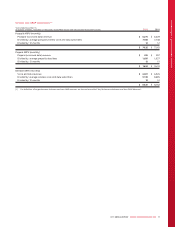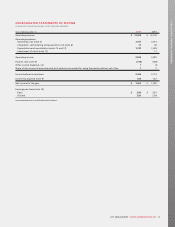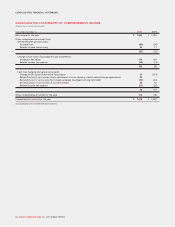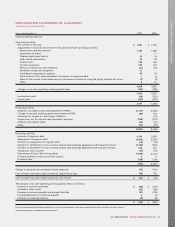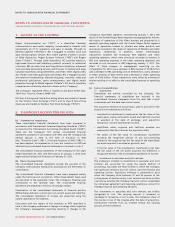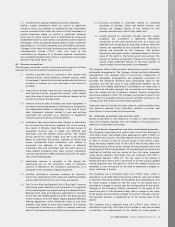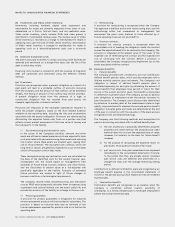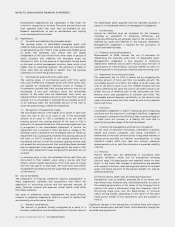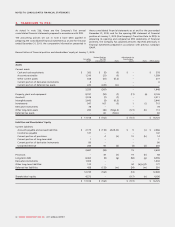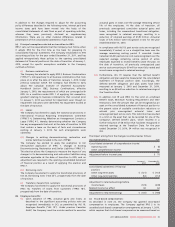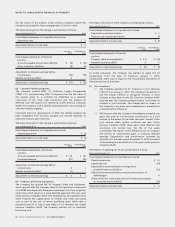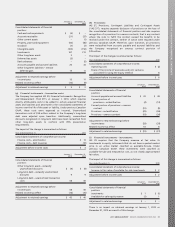Rogers 2011 Annual Report Download - page 91
Download and view the complete annual report
Please find page 91 of the 2011 Rogers annual report below. You can navigate through the pages in the report by either clicking on the pages listed below, or by using the keyword search tool below to find specific information within the annual report.
NOTES TO CONSOLIDATED FINANCIAL STATEMENTS
strategy in undertaking the hedge transaction and the
hedged risk, together with the methods that will be used
to assess the effectiveness of the hedging relationship. The
Company makes an assessment, both at the inception of
the hedge relationship as well as on an ongoing basis, of
whether the hedging instruments are expected to be highly
effective in offsetting the changes in the fair value or cash
flows of the respective hedged items attributable to the
hedged risk, and whether the actual results of each hedge
are within a range of 80 to 125 percent.
(iii) Impairment:
A financial asset carried at amortized cost is considered impaired
if objective evidence indicates that one or more events have had
a negative effect on the estimated future cash flow of that asset
that can be estimated reliably. Individually significant financial
assets are tested for impairment on an individual basis. The
remaining financial assets carried at amortized cost, are assessed
collectively, based on the nature of the asset.
An impairment loss in respect of a financial asset measured at
amortized cost is calculated as the difference between the asset’s
carrying amount and the present value of the estimated future
cash flows discounted at the asset’s original effective interest
rate. Losses are recognized in the consolidated statements of
income and reflected in an allowance account against accounts
receivable.
In assessing collective impairment, the Company uses historical
trends of the probability of default, timing of recoveries and the
amount of loss incurred, adjusted for management’s judgement
as to whether current economic and credit conditions are such
that the actual losses are likely to be greater or less than
suggested by historical trends.
An impairment loss on available-for-sale financial assets is
recognized by reclassifying the losses accumulated in the fair
value reserve in equity to the consolidated statements of
income. The cumulative loss that is reclassified from equity to
the consolidated statements of income is the difference between
the acquisition cost and the current fair value, less any
impairment loss previously recognized.
(iv) Fair values:
The Company determines the fair values of its financial
instruments as follows:
(a) the carrying amounts in the consolidated statements of
financial position of accounts receivable, bank
advances arising from outstanding cheques, accounts
payable and accrued liabilities and provisions
approximate fair values because of the short-term
nature of these financial instruments.
(b) the fair values of investments that are publicly traded
are determined by the quoted market values for each
of the investments.
(c) the fair values of private investments where no active
market exists are determined by using well established
market, asset based or projected income valuation
techniques which are applied appropriately to each
investment depending on its future operating and
profitability prospects. Management makes
assumptions that are based on market conditions
existing at the consolidated statements of financial
position dates.
(d) for disclosure purposes only, the fair values of each of
the Company’s public debt instruments are based on
the year-end trading values. The fair value of the bank
credit facility approximates its carrying amount since
the interest rates approximate current market rates.
(e) the fair values of the Company’s derivatives are
determined using an estimated credit-adjusted
mark-to-market valuation which involves increasing
the treasury-related (“risk-free”) discount rates used to
calculate the risk-free estimated mark-
to-market valuation by an estimated credit spread for
the relevant term and counterparty for each derivative.
In the case of derivatives in an asset position (i.e., those
derivatives for which the counterparties owe the
Company on a net basis), the credit spread for the
bank counterparty is added to the risk-free discount
rate to determine the estimated credit-adjusted value.
In the case of derivatives in a liability position (i.e.,
those derivatives for which the Company owes the
counterparties on a net basis), the Company’s credit
spread is added to the risk-free discount rate. The
change in fair value of the derivatives not designated
as hedges for accounting purposes are recorded
immediately in the consolidated statements of income.
The changes in fair value of the derivatives designated
as cash flow hedges for accounting purposes are
recorded in the hedging reserve within equity, to the
extent effective, until the variability of cash flows
relating to the hedged asset or liability is recognized in
the consolidated statements of income.
Fair value estimates are made at a specific point in time, based
on relevant market information and information about the
financial instruments. These estimates are subjective in nature
and involve uncertainties and matters of significant judgement.
Changes in assumptions could significantly affect the estimates.
The Company provides disclosure of the three-level hierarchy
that reflects the significance of the inputs used in making the
fair value measurements. Fair value of financial assets and
financial liabilities included in Level 1 are determined by
reference to quoted prices in active markets for identical assets
and liabilities. Financial assets and financial liabilities in Level 2
include valuations using inputs based on observable market
data, either directly or indirectly, other than the quoted prices.
Level 3 valuations are based on inputs that are not based on
observable market data.
(v) Current/non-current distinction:
Financial assets and liabilities due in part or in whole more than
one year from the consolidated statements of financial position
dates are considered to be non-current. Other financial assets
and liabilities are recognized as current. Financial assets and
liabilities are recognized and derecognized applying settlement
date accounting.
(j) Earnings per share:
The Company presents basic and diluted earnings per share data.
Basic earnings per share is calculated by dividing the income or loss
attributable to common shareholders of the Company by the
weighted average number of common shares outstanding during
the year. The diluted earnings per share is determined by adjusting
the income or loss attributable to common shareholders and the
weighted average number of common shares outstanding for
the effects of all dilutive potential common shares. The Company uses
the treasury stock method for calculating diluted earnings per share.
The diluted earnings per share calculation considers the impact of
employee stock options and other potentially dilutive instruments, as
disclosed in note 10.
2011 ANNUAL REPORT ROGERS COMMUNICATIONS INC. 87


